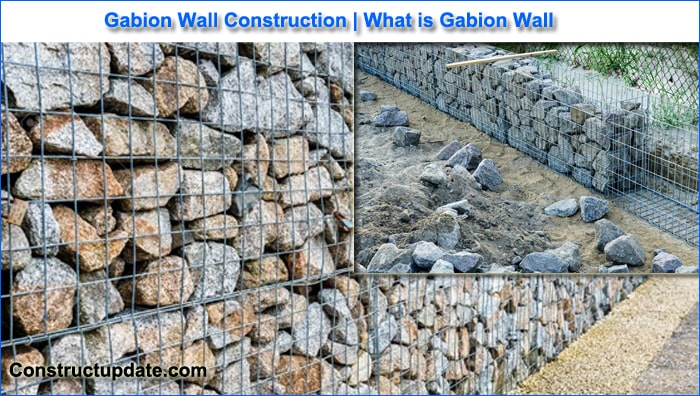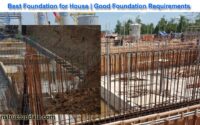Gabion Wall Construction | Purpose of Gabion Wall | Gabion Wall Application | Benefits of Gabion Wall
What is Gabion Walls?
A gabion wall is a visually stunning structure made of mountain granite that has been covered in gabions and secured with wire. Retaining walls made of gabions will typically deteriorate with the lean surface as a substitute for mountains.
The term “gabion” comes from an Old Italian word that meant “large jail.” A gabion wall is one type of gabion wall, and the wall with a gabion design will be used to protect the bank of the Nile River.
In middle age, a wall made of gabions will serve as an army castle, and in the past, building engineers have applied for many maintenance jobs.
The gabion retaining wall is intended for rural areas, where it will be used for many years as a magnetic type retaining wall and to build attractive walls in an orderly and simple manner.

Purpose of Gabion Walls:
The primary goal of gabion walls is to reduce land sliding along road edges, erosion, and scouring on the banks of rivers during floods and high-velocity river streams, as well as to stop the continued deterioration of waterlogged areas. They also serve as breast walls in steep places, supporting the moment of the soil and rock there. In order to give strength, efficiency, and structural stability while reducing the total estimating cost while maintaining the aesthetic needs, adhering to the actual design, and routine supervision, our primary objective is to shed light on the gabion wall’s dual behaviors.
Gabion walls can also be used as cover walls, but their primary use is to stabilise the soil beneath them. Depending on the wall’s height, gabion baskets are placed in one or more rows to make the wall. Baskets are enclosed on all sides and have a cage-like shape. They are constructed with broken rock that is arranged in baskets and hexagonal mesh that has been galvanised.
Retaining structures, an alternative to concrete structures for soil stabilisation, are made by stacking gabion baskets according to a set schedule.
Gabion Wall Construction:
While functioning as a permanent wall and conforming to the structure’s distance, gabion walls are extensively built to allow the soil below the wall to level out. It serves as a gabion holder for connecting several lines.
The gabion is constructed from broken stones, therefore these shattered stones are loaded inside the basket. The gabion basket walls have a cage-like shape and may be closed on all sides. The basket is made from galvanised hexagonal meshes. A collection of erosion-resistant gabion baskets are used to construct the gabion retaining walls.
In general, gabion basket dimensions are 2x1x1 m, and galvanised mesh dimensions are 810 cm, with the mesh having a hexagonal form and an eye size. Then, all baskets are positioned and secured with galvanised mesh wire to stop upper gabion walls or rows from deforming due to weight.
With the aid of a machine and a human hand, broken stones are placed into the basket as filler material. After entirely filling, close the basket and secure it with a galvanised steel ring.
Above the foundation, the gabion basket retaining wall’s initial layer is erected, and depending on the project’s specifications, it may be composed of stone or concrete. The second layer of the wall is positioned on a path that is advanced from the exterior toward the interior by a predetermined amount.
Following the completion of the basket work, the empty area behind the basket is filled with suitable material up to the second or upper layer of the gabion wall’s height. Fine stone material is positioned atop a geotextile on the back of the gabion wall.
Application of Gabion Wall:
- Retaining walls are built using gabion walls.
- Canal twining and river use gabion retaining walls.
- The bridge and road are protected by a gabion basket wall.
- Culverts, dams, and hydraulic structures all employ it.
- For construction on coastal embankments, it is utilised.
- Rockfall and soil erosion are protected by gabion basket walls.
- It is utilised for building and wall cladding.
- Environmental, noise, and wall barriers can all be created with gabion retaining walls.
Benefits of Gabion Walls:
- Gabion retaining walls are created from natural materials and blend in with the surroundings, giving them a more natural appearance.
- Compatibility with the Surrounding Environment: Gabion basket walls’ materials are readily available close to the construction site, which lowers the cost of shipping.
- Water permeability: Gabion retaining walls have good water permeability so they don’t harm the flowing water.
- The egress structure is being strengthened with basket retaining walls.
- These walls have more longevity because they are constructed from whole or fractured stones, which gives them greater stability, toughness, and longevity.
Advantages Of Gabion Wall
- Comparatively speaking, a gabion retaining wall is more durable than any other soil stabilisation system.
- Gabion walls are more adaptable. It is very simple to alter the width and height of a wall.
- A wall made of gabion baskets is permeable.
- Material viability is simple.
- Despite being expensive to build, gabion basket walls are cost-effective.
- It is environmentally friendly.
- The gabion wall is very strong.
Disadvantages of Gabion Wall
- Low habitat value can be found in gabion walls.
- Wall installation is a highly challenging operation.
- Due to wire abrasion in gabions, wire baskets may experience wear and tear.
- installing necessary tools and equipment is difficult.





